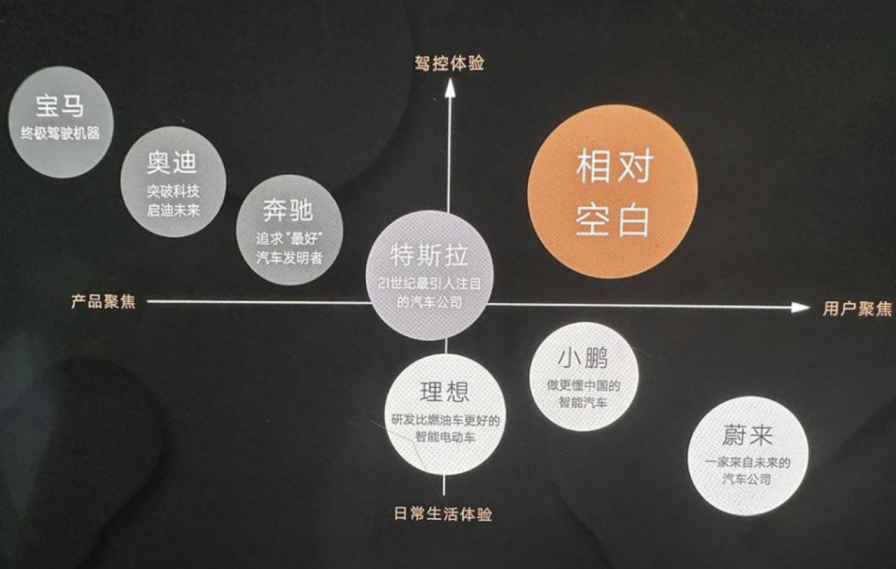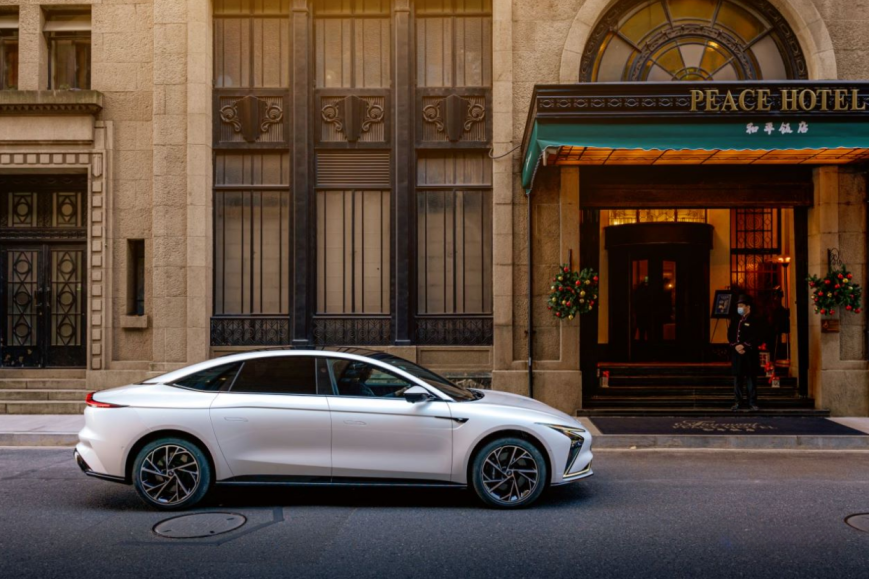On one side is the development of intelligent electric vehicles with a technological paradigm, while on the other side is the traditional approach of quality driving experience. IM has chosen the latter, but it is a difficult path and a long road.
In the era of intelligent electric vehicles, the vast majority of new brands boast of their intelligent attributes. With the rise of new brands, the racetrack for intelligent electric vehicles has become crowded, making it difficult for new brands to find their place.
To quickly raise awareness of their new brand, major brands often engage in arguments and hype on social media. “5 million bodies” and “Big-mouthed shelling” have become the new norm for the development of intelligent electric vehicles, leaving consumers overwhelmed. In such a competitive and inward-looking environment, it is increasingly difficult for brands to promote their own brand concepts.
Against this backdrop, IM has chosen to take a reverse development path, focusing on the driving experience favored by traditional car brands, and opening up a new era of “driving communication” for intelligent electric vehicles.
In the background of the exhausted label of intelligent electric vehicles, IM’s approach is a good choice.
As a new intelligent vehicle brand created jointly by SAIC Group, Zhangjiang High-tech and Alibaba Group, IM is not unfamiliar to people who pay attention to the development of intelligent vehicles. Its inherent advantages as a combination of traditional car companies and technology companies have given it more room for development.
“We respect the driving experience. Compared with traditional OEMs, IM places more emphasis on user focus, which is an originally empty market, and we have a competitive advantage. Our understanding of industry manufacturing, quality control, supply chain, chassis, power, and handling is better than that of early-stage internet entrepreneurs. This is our advantage,” said Liu Tao, CEO of IM.
To label the brand with the driving experience, Liu Tao has also spared no effort in promoting it. Although his video demonstrating L7’s driving performance sparked discussion among netizens about driving safety, it also enabled many onlookers to see IM’s strength in driving performance.In terms of driving performance, products under IM Auto do have their own unique features.
In March last year, IM L7 achieved a lap time of 1 minute 12 seconds and 94 milliseconds at the Shanghai Tianma Mountain racetrack, comparable to that of a 911.
In October, the IM L7 Snake Performance high-performance version set a lap record of 1 minute 42 seconds and 212 milliseconds, surpassing the AMG EQS and Porsche Taycan Turbo S, and becoming the “fastest production electric car” at the Zhejiang International Circuit.
As a brother model, the IM LS7 also continues the high-driving performance feature.
The new car is equipped with an air suspension chassis and adopts a lighter front double-wishbone and rear multi-link independent structure. Coupled with the master-level tuning by the WAE Williams Foresight Engineering team, the IM LS7 has a good driving performance.
In the background where many intelligent electric vehicles are pursuing larger and more screens, and striving for more radars and cameras for better assisted driving performance, IM chooses to break through in the opposite direction and establish its brand on the key point of driving performance, causing industry rethinking.
As Liu Tao said, “In the era of intelligent vehicles, the underlying understanding of automotive mechanical quality is still indispensable. It seems that only the big screen is the focus of intelligent vehicles, and driving performance seems to be unimportant, but I think this is wrong.”
The Radical “Traditional New Force”
Different from many new brands that put refrigerators, televisions, and small tables into cars to attract consumers’ attention, IM focuses more on expanding the core experience.Compared with the smart L7, the smart LS7 shows more obvious and careful thoughts on expanding the driving experience.
As a mid-to-large SUV model, the smart LS7 has a wheelbase of more than 3 meters and a vehicle length of more than 5 meters, which is comparable to the BMW X5 in size. This not only lays a foundation for its larger driving space, but also provides more imagination space for the interior layout.
The smart LS7 is equipped with a 1,955mm-long electric slide rail inside the cabin, which allows the flexible layout of the two right seats according to the actual needs of the passengers. The front passenger seat can realize 100% electric flat folding, and can slide and fold under the instrument panel.
As a result, the zero-gravity seat on the right side of the rear seat has more space to show off, providing consumers with a better riding experience.
As a new model positioned as a smart electric vehicle, the smart LS7 is also equipped with advanced intelligent driving assistance capabilities, including up to dual LIDAR and ORIN chip combination, which can realize high-speed navigation assistance NOA, automatic parking and other functions.
The assistance of driving functions largely reduces the “workload” of the driver, laying the foundation for the transformation of the steering wheel.
In the past, the steering wheel of a car has always been adding more functions to the easily reachable steering wheel, which has been the trend of the automotive industry development. With the advent of the intelligent era, the strengthening of assisted driving functions has made it possible to subtract from the steering wheel.
The smart LS7 adopts the first domestically produced half-wheel steering wheel for mass production, which not only adds to the technological sense of the whole vehicle but also reduces the steering wheel’s occupation of the driver’s field of vision. For more conservative users, the smart LS7 also offers a full-wheel steering wheel for optional installation, meeting different consumer demands.
The half-wheel steering wheel, combined with the liftable and adjustable central control screen and the front sky roof glass that extends to the top of the front row, makes the smart LS7 the SUV with the best view.Translate the Markdown Chinese text below into English Markdown text in a professional manner, retaining HTML tags inside Markdown and output only the result:
No matter the innovation in seat layout, or the changes to the steering wheel, central control screen, and front windshield, the IM LS7 is pursuing an even better driving experience, which is essentially an extension of various “traditional selling points” and forms a sharp contrast with the practice of installing refrigerators and TVs.
Capturing the consumers first is more important than establishing a “one super, many strong” brand tone
According to the plan, IM Motors aims to create a “one super, many strong” brand tone that combines “ultimate driving control+electric, intelligent, safe, and design”, with “one super” referring to driving control.
Liu Tao stated: “In the smart era, cars cannot only have one ‘longest plank’, but there must be one ‘longest plank’ that is really long. IM can make ‘driving control’ its longest plank.”

In other words, driving control will be the core competitiveness of IM Motors, and the new features of intelligent driving, intelligent cabin, and others in the smart electric era are important weapons for IM to attract new generation of consumers.
IM will also continuously strengthen its own layout in this field, forming a “one super, many strong” brand image of driving control + intelligent driving, intelligent cabin, and others.
Looking in the long run, this strategy is quite outstanding.
However, in the short term, it is difficult to reach the G-spot of the market, resulting in IM losing its potential to become a hit product.
“It is indeed difficult to create a control tag. BMW has used 20 years to firmly hold the control tag. IM does not have that much time to wait. However, we can explore and elevate the potential through product outperformance.”
Liu Tao has a clear understanding of this, but he underestimates the difficulty of building a control tag and the fierce market competition at present.
Taking the development of the gasoline-powered car era as an example, brands that focused on control were not only BMW.
Mazda, known as the “Japanese BMW,” and PSA, which emphasized chassis tuning, both regarded driving experience as the most direct selling point, but the effect was not obvious.
This is mainly because control needs to be experienced, and the feeling of control experience needs to be based on a large number of test drive experiences, which is the biggest shortcoming of ordinary consumers.In other words, it is difficult for ordinary consumers to distinguish between good handling experience and poor handling experience.
Based on this situation, looking back at BMW’s success, perhaps it was not completely due to its handling.
Instead, it was largely due to the brand’s appeal, as there are many consumers in today’s market who are willing to spend more money to buy a logo.
From this market experience, it is difficult for “driving experience” alone to break through the market and create a buying impulse for consumers, especially for a new brand that focuses on handling.
Therefore, IM urgently needs to tap into its potential to highlight more product advantages that can trigger consumer impulses.
IM seems to have gradually realized this point. The strategy of selling the IM LS7 at the price level of the NIO ES6 with the size of the NIO ES8 and the configuration of the NIO ES7 is a good strategy.
First, convert more consumers into IM users, and then highlight the driving performance advantage. With the accumulation of users, IM’s good reputation for handling performance will gradually spread in a larger range and its driving performance advantage will gradually form.
This article is a translation by ChatGPT of a Chinese report from 42HOW. If you have any questions about it, please email bd@42how.com.
